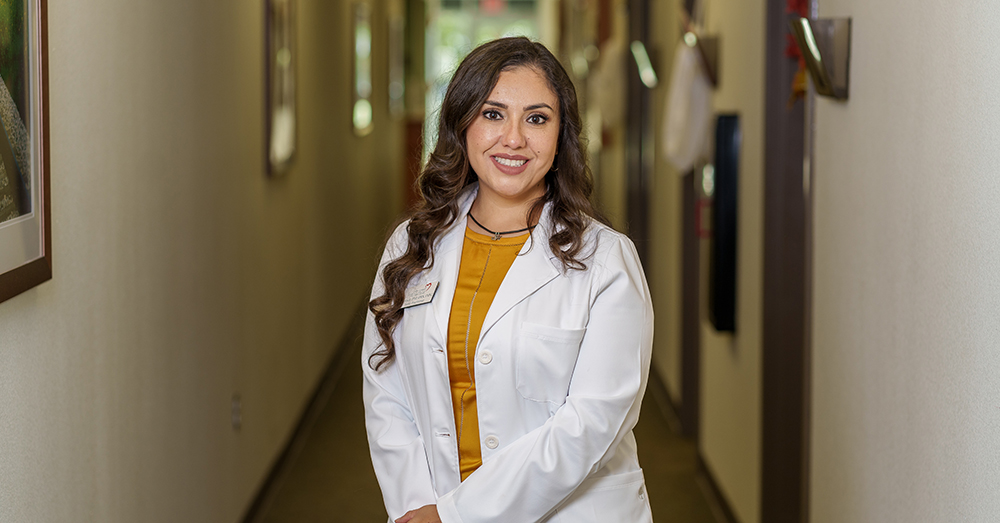Men, Women at Risk for Breast Cancer

Veronica L. Estrada, DNP, R.N.
Although October is best known for fall festivities, it also is a month filled with national and global observances, including Breast Cancer Awareness Month. Everyone knows someone impacted by breast cancer — family member, friend, co-worker or someone in the community. Although there have been tremendous efforts in the fight against breast cancer, the disease continues to impact 1 in 8 women in the United States. Hispanic/Latina women are more likely to be diagnosed with breast cancer later than white women.
According to the American Cancer Society, breast cancer is the second most common cancer and the second leading cause of cancer deaths among women in the United States. In 2022 alone, approximately 287,850 women will be diagnosed with invasive breast cancer; 51,400 women will be diagnosed with ductal carcinoma in situ (DCIS) or non-invasive breast cancer; and approximately 43,250 women will die as a result of breast cancer. Although it is less common, men also are at risk for developing the disease. The National Foundation of Breast Cancer, Inc. estimates in 2022, approximately 2,710 men will be diagnosed with breast cancer, and an estimated 530 men will die from it.
According to breast cancer organization Susan G. Komen, early-stage breast cancer cases in the United States are most often diagnosed through screening mammography before the development of any signs or symptoms. It is essential to understand that breast cancer signs are not always the same in everyone, but most often can present as changes in how the breast or nipples feel and look. Symptoms include lumps in the breast or underarm area, changes in the texture of the breast skin/pores described as having the appearance of an orange peel texture, and unexplained changes in the size or shape of the breast, primarily if it is occurring on one side only.
Changes in the nipples, such as nipple discharge in non-lactating women (particularly clear or bloody in appearance) or an inverted nipple, can indicate breast cancer. Everyone must be familiar with the signs and symptoms of breast cancer. All breast changes/abnormalities warrant further evaluation by a health care professional. Although breast cancer is not preventable, it can be detected early through appropriate screening.
The National Foundation of Breast Cancer, Inc. recommends that adult women perform self-breast exams monthly; self-breast exams allow for women to be familiar with their normal breast anatomy and recognize changes early. The most effective test to help detect breast cancer is a screening mammogram, which is a test that uses X-ray technology to evaluate breast tissue for any potential areas of concern. All women age 40 and older should have an annual mammogram. Women who are younger than 40 and have risk factors for breast cancer should discuss with their health care provider when to begin screening and how often.
Everyone is at risk of developing breast cancer. Factors including gender, family history, age, lifestyle and ethnicity contribute to a person's risk of developing breast cancer. As we age, the risk increases. Women are at an increased risk of developing breast cancer compared to men, and a family history of breast cancer may also increase a person's risk of developing the disease. According to Susan G. Komen, Caucasian and African American women have a higher risk of breast cancer development than other ethnicities.
Everyone should have the opportunity to be as healthy as possible regardless of their socioeconomic status, cultural background and level of education. To raise awareness, reduce mortality and improve access to screening, we must work together to reduce barriers and enhance equity. According to National Breast Cancer Foundation (2022), 47% of women postpone preventative services such as mammograms due to cost. Breast cancer survival rates are directly impacted by socioeconomic status, level of education and access to health care coverage.
This October, I encourage you to do more than wear pink. Urge the women around you to get their mammograms and talk with their health care providers if they notice changes in their breasts and become familiar with community resources available to increase health equity.
Veronica L. Estrada, DNP, R.N., is a nurse practitioner in the Texas Tech University Health Sciences Center School of Nursing’s Larry Combest Community Health & Wellness Center.
Related Stories
TTUHSC Dean to be Inducted into the National Academies of Practice as Distinguished Fellow
Gerard E. Carrino, Ph.D., MPH, dean of the TTUHSC Julia Jones Matthews School of Population and Public Health, will be inducted into the National Academies of Practice (NAP) as a Distinguished Fellow of the Public Health Academy.
TTUHSC School of Nursing Celebrates 10-Year Anniversary of the Abilene Community Health Center
The TTUHSC School of Nursing hosted a 10-Year Anniversary Celebration and Open House for the Abilene Community Health Center. The center is one of 71 Federally Qualified Health Centers (FQHCs) in Texas according to the Texas Health and Human Services.
TTUHSC Receives $1.3 Million HRSA Telehealth Resource Center Grant to Expand Telehealth in Texas and Louisiana
The TexLa Telehealth Resource Center, based at TTUHSC, has been awarded a $1.3 million, four-year grant from HRSA to strengthen and expand digital health services in Texas and Louisiana.
Recent Stories
TTUHSC Cancer Researcher Honored by National Academy of Inventors
C. Patrick Reynolds, M.D., Ph.D., director of the School of Medicine Pediatric Cancer Research Center at TTUHSC, has dedicated his life as a researcher to developing treatments for childhood cancers.
TTUHSC School of Nursing Celebrates 10 Years of the Veteran to BSN Program
The TTUHSC School of Nursing recognized the 10-year anniversary of the Veteran to Bachelor of Science in Nursing (VBSN) program during the fall 2025 commencement ceremonies held Dec. 13 in Lubbock, Texas.
TTUHSC Dean to be Inducted into the National Academies of Practice as Distinguished Fellow
Gerard E. Carrino, Ph.D., MPH, dean of the TTUHSC Julia Jones Matthews School of Population and Public Health, will be inducted into the National Academies of Practice (NAP) as a Distinguished Fellow of the Public Health Academy.
